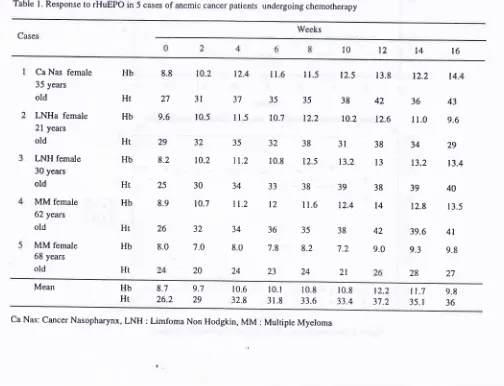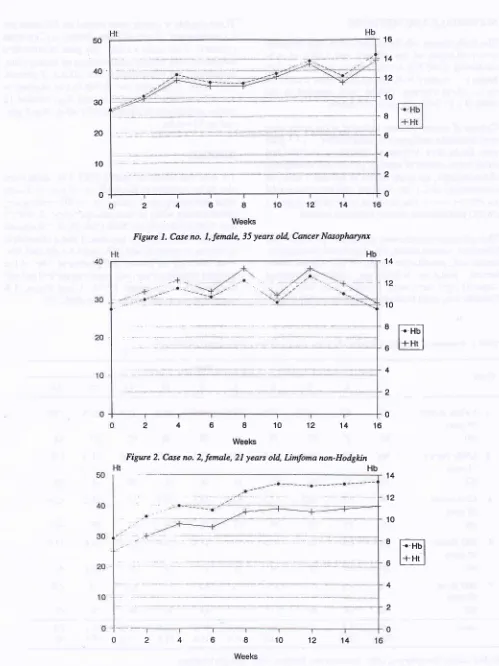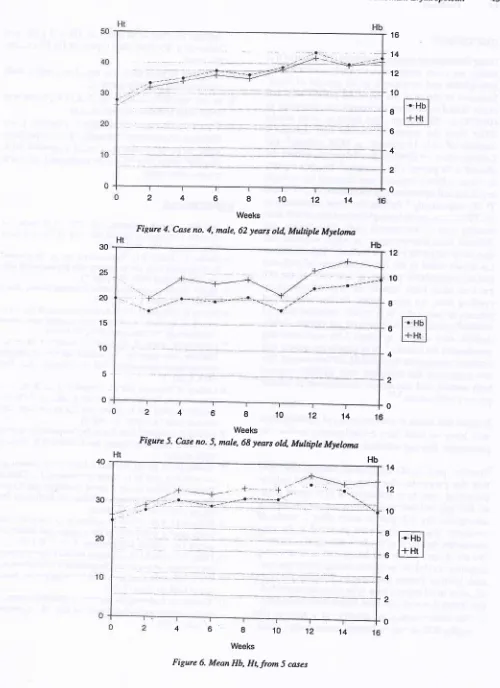Med J Indones
40
TambunanExperience
in
the
Use
of
Human
Recombinant
Erythropoietin
(rHuEPO)
in
Cancer Patient
with
Anemia
Karmel
L.Tambunan,
Aru
Sudoyo,
A.Harryanto
Reksodiputro *
Abstrak
Anemia pada pendeita kanker dapat disebabkan berbagai faktor seperti toksis sitostatika pada sumsum tulang, defsiensi besi, asamfol.at,hemolitikdanperdarahan.Anemiaini seringdiserlai'kadareitropoitinyangrelatifkurang. Atasdasarkenyataantersebut
di aàs
diharapkan pem-berian eitropoietin padapeiderita
kanker al<nn dapat lebih merangsang erifto-poiesis dan menaik*an hemoglobin. pasien yangditeliti
yaiti p"ndiita
kanker yang sedang mendapat kemoterapi disertai anemia, dan penyebab anemia bukan karena hemolitik, defisiens[ besi, àefisiensi asamfotat dàn defsiensi Btz.. Pasien yang dileliti terdiri dari]
knsus Ca nasoJaring, 2 kasus limfomamalignumâan2 kasus mu[tiplemyeloma. Pasien diberirHuEPo 150 iu/kg, subkutan 3 kali seminggu, selama I6 minggu' Dilakukanpemeriksaanhemoglobin(Hb)danhematokrit(Ht)tiapminggudanpadamingguke-l2ditemukan kenaikanHb>2gvodanHt >
6vo pada 4 t<,,sus (gyvo*) dan pada satu kasus walaupun kenaikan Hb<
2 gEo tetapi menjadi bebasdari
kebutuhan transfusi' pemberian rHuEpO seperti tersebul di otot dapat meningkatkan hemoglobin penderita kanker dengan anemia.Abstract
Anemia in cancer patients can be the result of a variety of
factors,
often in combination. The chemotherapy-related myelosup' pressionis
logically the main cause, but other condi.itions sometimes prevail, such as iron or folate deficiency, hemolysis, bleeding, or, as mentioned before, the combination of the above, Known as ane nia of cancer or chronic disease, it is heralded by the disturbanceof
iron utilization and, recently, found to be accompanied by low eryIhropoetin levels.It
is with the latter condition in mind that we have undertakena
study ,oorrrri
i"rponsiveness of the anemia of cancer to erythropoetin,in
this case the human recombinant erythropoetin (rHuEpO). Five cancer patients withvarying types of cancers who have undergone chemotherapy were recruited, and received THuEPO 150 iu/kg, thrice weekly subcutaneouslyfor
a
peiod
of 16 weeks. Hemoglobin levels and hemalocrit were monitored and at 12 weeks was noted an increase in hemoglobini"i"k
by^or"
than 2 g/dl and hematocrit measurement by more than 67o in 4 cases (80Vo). one casehad
increases less than'the aforemeniioned but was made transfusion-free. We conclude thatrHuEPo
hasan
impressive he mo g lo b in- increas i n g efe ct.Keywords
:
erythropoietin, anemia, ancer patient.level
of
endogenouserythropoietin
(EPO) that
arein-appropriately
low for
the
degree
of
the
anemia,
ablunted EPO
responseto hypoxia
and
low
red
blood
cell production.
Theconcentration of erythropoietin
in
the serum cancerpatients
is lower
that
expected com-pareto patients
with iron deficiency un"-iu.2
Several studies groups have
reported
thatrecombinant
human
eritropoietin (rHuEPO)
is
able improved
anemiain
cancer patient.3These
early
observations
led to
the conclusion
that
THuEPOcould
bebeneficial
for
cancer patients
with
anemia. The aimof
this study is to evaluate theefficacy
of of
the
use
of
THuEPO
in
anemic
cancer patients
undergoing chemotherapy.
Anemia
is aproblem in
patientswith
advanced cancer'Blood transfusion may
be required
in
many
of
thesepatients,
particularly
thoseundergoing chemotherapy'
Anemia
in cancer maybemultifactorial
in etiology
and can be causedby
avariety of
conditions,
among theseare, i.e., iron
or folic
acid deficiency, hemolysis
or
bleeding.
In
the
cancer patient receiving
chemo-therapy,
the anemia can be aggravated by the effectsof
cytostatic-rel
atedmyelosuppresion.
Generally,
thetype
of
anemiain
cancerpatients
is
of
the chronic disorder
type,l
characterized
by
serumVol6, No
I,
January - March 1997MATERIALS
AND METHODS
The study design
will
be anopen label,
noncompara-tive
evaluation
of
the eficacy
and safety
of
sub-cutaneous THuEPO administration
in
patient with
anemia
secondary
with
malignancy
been treated by
cyclic
chemotherapy. Patient were enrolled
in
thestudy
if
they
fulfil
the
inclusion
crireria.
Criteria of
cancer patients
included in
the study
werenon leukemia malignancy; hemoglobin
<
10,5
g/dl;
iron,
folate,812
deficiency,
hemolysis
andbleeding
ruled out
as causesof
anemia;patient
still
undergoing
chemotherapy;
no
acute
illness
in
the last
7
days;
noradiotherapy
in
the last 30
days;
life
expectancy
of
6months or
more;
performance score
of
0,I,2,
or
3,''l(WHO
performance
status);informed
consent.The patients
underwent complete
physical
and
laboratory examinations, which
included
hemoglobin,
hematocrit, reticulocyte
count,
WBC,
platelet count,
ureum, creatinine, serum
iron,
total
iron
binding
capacity,
glucose,
total
protein,
folic
acid,
Bl2,
Coombs
test,stool
hematest, andprothrombin
time.
Table
l.
Response to THuEPO in 5 cases of anemic cancer patientsHuman Recombinant
Erythropoietin 4l
Those
eligibte for
study wers
startedon
150u$its
Derkg bodyweight
of
recombinanr
human erythrpoietin
(rHuEPO)
threetimes
aweek.
The patients were
thenmonitored
with weekly
examinations
of
hemoglobin,
hematocrit,
andreticulocytes. Side effects,
if
present,were noted.
A response was
defined
as an increasein
hemoglobin concentration
of
atleast 2
g/dl
within
12weeks,
or
increasein
hematocrit
by
more than
6
per-cent
in
l2
weeks.RESULTS
The
trial
was startedin August
1993.Five
cases \r/ereable
to
beincluded
in
the study,
consisting
of
I
casewith
nasopharyngeal cancer stage
III
undergoing
chemotherapywith platinum
andepirubicin,2
cases,ofnon-Hodgkin lymphoma, both
stageIII,
at thattime
on theCHOP chemotherapy regimen,
2 casesof multiple
myeloma,
at stagesII
andIIIA,
respectively,
andwho
were receiving
melphalan
andprednison. One
of the
multiple
myeloma
cases wasrequiring
packed redcell
transfusions every month (Table
I
and
Figure
l-6
showed response
to treatment
with
THuEPO).undergoing chemotherapy
Weeks
l6
t4 t2
l0
Ca Nas female 35 years old
LNHa
female2l
years oldLNH female 30 years old
MM
female 62 years oldMM
female 68 years oldt4.4
43
9.6 I 1.5
35
t2.2
t24
Hr
27 31
37Hb
9.6 t0.5
II
5to.2 8.8 Hb I1.6 35 10.7 t2.5 38 10.2
3l
13.2 13.8 42 12.6 t2.2 36 I1.0 34 13.2 39 12.8 39.6 9.3 28Hr 29
32Hb 8.2
tO 2Hr
25Hb
8.932
r0.8
34
33ll2
12Hr
26
32
34
36Hb
8.0 7.0
8.0
7.835 11.2 38 12.5 38 I 1.6 35 8.2 24 38
l3
39
38124
t4
4t
9.8
27
38
427.2
9.021
29
13.4
40
r 3.5
30
10.7
23 24
20
Mean
l0
6
l0.l
32
8
31.8 HbHt 26.28.7 9.7 29 10.8 33.6 12.2 37.2 10.8 33.4 11.7 35. r
9.8 36
[image:2.595.43.547.406.792.2]Med J Indones
42
Tmùman
50
40'
30
20
10
o
16
14
't2
10
I
t
4
2
0
246810121416
[image:3.595.57.556.66.732.2]Weeks
Figure
L
Case no. I, female, 35 years old, Cancer Nasopharynx2468't0
12 14
16Weeks
Figure 2. Case no. 2, female, 21 years old, Limfoma non-Hodgkin
Hb
2468101214
Weeks
Figure 3. Case no. 3, rnale, 30 years old, Limfoma non-Hodgkin
Hb
HI
14
12
10
I [-;bl
u
l*t'
I4
2
0
't4
12
10
I l-
HËlu
l*t,
I4
2
VoI6, No
I,
tanuary - March 1997 H uman R ec omb inan t Ery throp oie tin 43
't6
14
12
10
I
6
4
2
0
2468101214
[image:4.595.57.557.61.749.2]Weeks
Figure 4. Case no.4, male, 62 years old, Muttiple Myeloma
Ht 30
25
20
15
10
5
o
Hb
12
10
I
6
4
2
0
14
12
10
I
l;Hbl
.
l*t,
I4
2
0 Ht
2468101214
16Weeks
Figure 5. Case no. 5, male, 6g years old, Multiple Myeloma
a a
4
6
''= I
10
12 WeeksFigure 6. Mean Hb, Ht,from 5 cases
Hb
40
30
20
M
TambunanDISCUSSION
made
transfusion-free
increased
the
response
to
actually
seenby
the
second week.
This finding
wast
in which
resPonse wasstudied.T
This difference
r's inclusion of
leukemia
and
myelodysplastic patients
in
that study,
as thetwo
entitiés
havJ
been
known
to
respond
poorly
to
erythropoetin, the
same reason
for
the exclusion
of
puti"ntt in
our study'
In
areview compiled
from
12medical institutions, 616 patients on
cancer
chemo-therapy were studied,
in
which
l27o werc
receiving
transiùsions
for
anemia.8
In
this
study onepatient
wasrendered
transfusion-free
after THuEPOtreatment'
Theothers
reported
thattreatment
with
THuEPO
reducedboth
anemia
and transfusion requirement
in
anemicpatients
with
cancer'9' loIt
seems thatfuture
studiesin
the useof erythropoietin
will
have
to
take
into
consideration factors
or
parameters that
caninfluence
response'That
s andfound
that
ant
role
in
pred
erum levels
of I
increase
in
of cancer
involved will
have to be takeninto
considera-tion. From this study
we havedrawn
theseconclusion:
1)
The administration
of
THuEPO
in
a
dose
of
150mg/kg
BW
in
cancer patients undergoing
chemo-Med J Indones
therapy
resulted
in
an
increase
flb
>
2 gldl
andhematocrit by
more than
6percent
(in
80 percent
of
cases).2)
Responseto
treatment was
noted at week 2 with
maximum
increase bYweek
12.3)
In
one casewith multiple
myeloma
thepatient
wasfreed
from
transfusion requirement.
4)
Cases
with
naso-pharyngeal cancer,
non-Hodgkin's
lymphoma,
andmultiple
myeloma
havegood
hop"
of
attaining
a
good response
with
iffuBpO
when thepreviously
mentioned
inclusion
criteria
were
used.REFERENCES
l.
Bun HF.
Anemia associatedwith
chronic. disorders' InHarrison's Principle of Internal Me'dicine
1lù
edition' NewYork: McGraw
Hill
1987.1504-5.2.
Miller
C,
JonesRJ, Plantodasi's
et
al'
DecreasedEryhtropoietin response in patients with the anemia of
can-cer. N Eng J Med 1990, 322'1689-92.
3. Abel R. Erythropoietin for Anemia in Cancer Patient : Eur
I
Cancer 29 A. SuPPI
2'
1993,52-8'4. Bowen D, Culligan D, Jacob A. The treatment of anemia in
the myelodysplastic syndrome
with
recombinant humanerythropoietin. Br J Haematol
l99l;77:419-33'
5.
t
uOwig
H, Frizt E,
Leitgeb C, Krehner
M
et
al'
Erythropoietin treatmentfor
chronic anemiaof
selectedhematological malignancies and solid tumors'
Ann
Onc1993,4, 16l-7.
6. Ludwig H, Petcherstorfer
M,
Leitgeb C, FriztE'
Recom-binant Human Erythropoietin for the trreatment of Chronic
Anemia
in
Multiple
Myeloma and SquamousCell
Car-cinoma. Stem Cell 1993.;
ll:
348-55.7. Ludwi g H, Lei tgeb C, Frizt E et al. Erythropoietin Treatment
of Chronic Anemia of Cancer. Eur J Cancer 29A' Suppl 2'
1993, S8-S12.
8. Skilling JR, Roger MI, Nabolitz
IM
et al' Anepidemiologi-cal review
of
anemiain
cancer chemotherapyin
Canada'European Conference
on
Clinical Oncology and CancerNursing / European Society of Therapeutic Radiologic
On-cology 1995, Paris, Oct 29-Nov 2.
9.
Bukowski
RM. Clinical
efficacy
of
recombinant
erythropoietin (rHuEPO),
in
the treatmentof
anemiaas-sociated with cancer. Eryhtropoiesis 1994, 5, 108-14'
10. Henry DH, Abel RI' Recombinant human eryhtropoietin in
the treatment of cancer and chemotherapy induced anemia'
result double blind and open labet follow up studies' Semin
Oncol 1994,21, SuPPI
3,21-8-I
l.
Thatcher N. Predicting the response to THuEPO in anaemic

